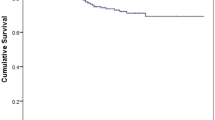Abstract
To evaluate the outcomes of repeat corneal transplantation, either penetrating keratoplasty (PKP) or Descemet’s stripping automated endothelial keratoplasty (DSAEK), for penetrating keratoplasty grafts which failed due to corneal edema. The charts of 24 eyes with failed PKP grafts, due to corneal edema, which underwent a repeat corneal transplant (PKP in 17 eyes [Group 1] and DSAEK in seven eyes [Group 2]) between 2003 and 2007 were retrospectively reviewed. There was no statistically significant difference in the median postoperative visual acuity between the two groups at 1, 2, or 3 years. In Group 1, two (18%) eyes had a final visual acuity ≥20/40, in contrast to four (80%) eyes in Group 2, which was statistically significant (P = 0.038). Seven (41%) of the Group 1 eyes developed postoperative complications compared to only one (14%) eye in Group 2. Eleven (65%) of the Group 1 eyes and five (71%) of Group 2 eyes had clear grafts on the last examination. There was no statistically significant difference in the graft survival rate for Group 1 versus Group 2 at 3 years (57.9% vs 68.6%, P = 0.507). There was a trend towards better postoperative visual acuity, a lower postoperative complication rate, and a higher graft survival rate in eyes that underwent DSAEK rather than repeat PKP for graft failure secondary to corneal edema. Given this small, retrospective study, future studies comparing repeat PKP with DSAEK are warranted to determine which procedure allows for improved outcomes.


Similar content being viewed by others
References
Bersudsky V, Blum-Hareuveni T, Rehany U et al (2001) The profile of repeated corneal transplantation. Ophthalmology 108:461–469
Al-Mezaine H, Wagoner MD, the King Khaled Eye Specialist Hospital Cornea Transplant Study Group (2006) Repeat penetrating keratoplasty: indications, graft survival, and visual outcome. Br J Ophthalmol 90:324–327
Vanathi M, Sharma N, Sinha R et al (2005) Indications and outcomes of repeat penetrating keratoplasty in India. BMC Ophthalmol 5:26
Weisbrod DJ, Sit M, Naor J et al (2003) Outcomes of repeat penetrating keratoplasty and risk factors for graft failure. Cornea 22:429–434
Patel NP, Kim T, Rapuano C et al (2000) Indications for and outcomes of repeat penetrating keratoplasty, 1989–1995. Ophthalmology 107:719–724
Rapuano CJ, Cohen EJ, Brady SE et al (1990) Indications for and outcomes of repeat penetrating keratoplasty. Am J Ophthalmol 109:689–695
Robinson CH (1979) Indications, complications and prognosis for repeat penetrating keratoplasty. Ophthalmic Surg 10:27–34
Insler MS, Pechous B (1986) Visual results in repeat penetrating keratoplasty. Am J Ophthalmol 102:371–375
Cowden J, Kaufman HE, Polack FM (1974) The prognosis of keratoplasty after previous graft failures. Am J Ophthalmol 78:523–525
Kirkness CM, Ezra E, Rice NS et al (1990) The success and survival of repeat corneal grafts. Eye 4:58–64
Yalniz-Akkaya Z, Nurozler AB, Ylidiz EH et al (2009) Repeat penetrating keratoplasty: indications and prognosis, 1995–2005. Eur J Ophthalmol 19:362–368
MacEwen CJ, Khan ZU, Anderson E et al (1988) Corneal re-graft: indications and outcomes. Ophthalmic Surg 19:706–712
Covert DJ, Koenig SB (2007) Descemet stripping and automated endothelial keratoplasty (DSAEK) in eyes with failed penetrating keratoplasty. Cornea 26:692–696
Price FW, Price MO (2006) Endothelial keratoplasty to restore clarity to a failed penetrating graft. Cornea 25:895–899
Price FW, Price MO (2006) Descemet’s stripping endothelial keratoplasty in 200 eyes: early challenges and techniques to enhance donor adherence. J Cataract Refract Surg 32:411–418
Wendel LJ, Goins KM, Sutphin JE et al (2011) Comparison of bifold forceps and cartridge injector suture pull-through insertion techniques for Descemet stripping automated endothelial keratoplasty. Cornea 30:273–276
Wandling GR, Parikh M, Robinson C et al (2010) Escalation of glaucoma therapy after deep lamellar endothelial keratoplasty. Cornea 29:991–995
Cosar CB, Sridhar MS, Cohen EJ et al (2002) Indications for penetrating keratoplasty and associated procedures, 1996–2000. Cornea 21:148–151
Al-Towerki A, Al-Rajhi AA, Wagoner MD (2004) Changing indications for keratoplasty at the King Khaled eye specialist hospital (1983–2002). Cornea 23:584–588
Koenig SB, Covert DJ, Dupps WJ Jr et al (2007) Visual acuity, refractive error and endothelial cell density six months after Descemet’s stripping and automated endothelial keratoplasty (DSAEK). Cornea 26:670–674
Terry MA (2006) Endothelial keratoplasty: history, current state, and future directions. Cornea 25:873–878
Rumelt S, Bersudsky V, Blum-Hareuveni T et al (2002) Preexisting and postoperative glaucoma in repeated corneal transplantation. Cornea 21:759–765
Rumelt S, Bersudsky V, Blum-Hareuveni T et al (2008) Persistent epithelial defects and ulcers in repeated corneal transplantation: incidence, causative agents, predisposing factors and treatment outcomes. Graefes Arch Clin Exp Ophthalmol 246:1139–1145
Terry MA, Hoar KL, Wall J, Ousley P (2006) Histology of dislocations in endothelial keratoplasty (DSEK and DLEK): a laboratory-based, surgical solution to dislocations in 100 consecutive DSEK cases. Cornea 25:926–932
Conflict of interest
No conflicting relationship exists for any author.
Author information
Authors and Affiliations
Corresponding author
Rights and permissions
About this article
Cite this article
Kitzmann, A.S., Wandling, G.R., Sutphin, J.E. et al. Comparison of outcomes of penetrating keratoplasty versus Descemet’s stripping automated endothelial keratoplasty for penetrating keratoplasty graft failure due to corneal edema. Int Ophthalmol 32, 15–23 (2012). https://doi.org/10.1007/s10792-012-9518-4
Received:
Accepted:
Published:
Issue Date:
DOI: https://doi.org/10.1007/s10792-012-9518-4




